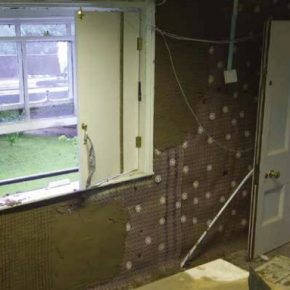
Delta Membranes: What do we mean by Types A, B & C Waterproofing?
Waterproofing is the process of making an object or structure waterproof or water-resistant, so it remains relatively unaffected by water or resisting the ingress of water under specified conditions. Buildings all around the world rely on structural waterproofing systems. Delta Membranes takes an insightful look…
The difference between waterproof and damp proof?
Waterproof refers to the penetration of water (in its liquid state) and possibly under pressure. Structural waterproofing is a general term within the industry that covers methods and treatments to describe waterproofing any structure.
Waterproofing or Structural Waterproofing is applicable to any construction under-ground or below ground level.
Damp proof refers to resistance to humidity or dampness.
Damp proofing is a general term that covers methods and treatments used to prevent damp from being absorbed through walls or floors into the interior of a structure above ground.

BS8102:2009
BS8102:2009 Code of Practice for the Protection of Below Ground Structures Against Water from the Ground is the British Standard which gives recommendations and provides guidance on methods of dealing with and preventing the entry of water from surrounding ground into a structure at below ground level.
It states that there are 3 types of waterproofing protection:
Type A (Barrier) Protection
Type A (Barrier) Protection, also historically referred to as ‘Tanking’, provides protection against ground water ingress by applying a waterproof material to the internal or external walls and floor slab of a basement or underground structure forming a barrier between the structure and any groundwater present.
Historically, methods for Type A systems included internal, external and sandwich.
Type B (Structurally Integral) Protection
Type B protection is provided by the structure itself against water ingress. Type B Protection relies heavily on the design and materials incorporated into the external shell of the structure.
Design, materials, as well as the quality of the workmanship contribute to the success of Type B Systems. The pattern of any seepage encountered is often associated with poor joints, cracks or other discontinuities such as service penetrations.
Type C (Drained) Protection
Type C protection is provided by the incorporation of an appropriate internal water management system.
Type C Protection allows moisture or running water to penetrate through the external wall or floor of the structure and to travel behind the membrane in a controlled drainage system.
Type C systems collect and manage any water ingress by diverting it into a designated safe point of disposal (such as a sump pump/package pump station).
Cavity Drain Membranes are studded on the external facing surface, allowing any water that penetrates the structure to flow into designed drainage channels.
The drainage channels carry any water ingress to either a sump and pump chamber or away from the structure if passive drainage is possible.
Delta Membrane Systems,
Delta House,
Merlin Way,
North Weald,
Epping,
Essex,
CM16 6HR
United Kingdom
Visit Delta Membrane Systems' website
Visit Supplier's page
Latest news

28th March 2025
Ideal Heating Commercial announces 10-year warranty on Evomax 2 boiler
Evomax 2, the UK’s number one selling commercial wall-mounted boiler from Ideal Heating Commercial, is now available with a 10-year warranty.
Posted in Articles, Building Industry News, Building Products & Structures, Building Regulations & Accreditations, Building Services, Facility Management & Building Services, Heating Systems, Controls and Management, Heating, Ventilation and Air Conditioning - HVAC, Innovations & New Products, Pipes, Pipes & Fittings, Plumbing, Retrofit & Renovation, Sustainability & Energy Efficiency, Videos
28th March 2025
FLIR Si1-LD Acoustic Imaging Camera for Compressed Air Leak Detection
FLIR, a Teledyne Technologies company, introduces the Si1-LD, an industrial acoustic imaging camera that brings faster and more accurate compressed air leak detection to those operating on a modest condition monitoring budget.
Posted in Acoustics, Noise & Vibration Control, Articles, Building Industry News, Building Products & Structures, Building Services, Facility Management & Building Services, Information Technology, Innovations & New Products, Retrofit & Renovation, Sustainability & Energy Efficiency, Thermal Imaging and Monitors
28th March 2025
LIFTEX 2025 Seminar programme announced
Registration has opened for LIFTEX 2025. Now in its 37th year, LIFTEX 2025 is the UK’s only dedicated exhibition for the lift, escalator and access industry and takes place only once every three years.
Posted in Access Control & Door Entry Systems, Accessibility, Articles, Building Industry Events, Building Industry News, Building Products & Structures, Building Regulations & Accreditations, Building Services, Exhibitions and Conferences, Facility Management & Building Services, Health & Safety, Retrofit & Renovation, Security and Fire Protection, Seminars
28th March 2025
MCRMA welcomes ArcelorMittal UK to membership
A UK division of the global steelmaking business ArcelorMittal has become the latest new member of the MCRMA, the industry association representing the metal building envelope sector.
Posted in Articles, Building Associations & Institutes, Building Industry News, Building Products & Structures, Building Systems, Cladding, Facades, Posts, Restoration & Refurbishment, Retrofit & Renovation, Roofs, Steel and Structural Frames, Walls
 Sign up:
Sign up: